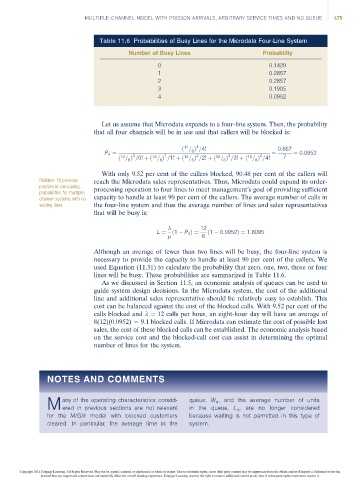Page 495 -
P. 495
MULTIPLE-CHANNEL MODEL WITH POISSON ARRIVALS, ARBITRARY SERVICE TIMES AND NO QUEUE 475
Table 11.6 Probabilities of Busy Lines for the Microdata Four-Line System
Number of Busy Lines Probability
0 0.1429
1 0.2857
2 0.2857
3 0.1905
4 0.0952
Let us assume that Microdata expands to a four-line system. Then, the probability
that all four channels will be in use and that callers will be blocked is:
4
12
ð = Þ =4! 0:667
P 4 ¼ 0 1 6 2 3 4 ¼ ¼ 0:0952
12
12
12
12
12
ð = Þ =0! þð = Þ =1! þð = Þ =2! þð = Þ =3! þð = Þ =4! 7
6
6
6
6
6
With only 9.52 per cent of the callers blocked, 90.48 per cent of the callers will
Problem 18 provides reach the Microdata sales representatives. Thus, Microdata could expand its order-
practise in calculating
probabilities for multiple- processing operation to four lines to meet management’s goal of providing sufficient
channel systems with no capacity to handle at least 90 per cent of the callers. The average number of calls in
waiting lines. the four-line system and thus the average number of lines and sales representatives
that will be busy is:
12
L ¼ ð1 P 4 Þ¼ ð1 0:0952Þ¼ 1:8095
6
Although an average of fewer than two lines will be busy, the four-line system is
necessary to provide the capacity to handle at least 90 per cent of the callers. We
used Equation (11.31) to calculate the probability that zero, one, two, three or four
lines will be busy. These probabilities are summarized in Table 11.6.
As we discussed in Section 11.5, an economic analysis of queues can be used to
guide system design decisions. In the Microdata system, the cost of the additional
line and additional sales representative should be relatively easy to establish. This
cost can be balanced against the cost of the blocked calls. With 9.52 per cent of the
calls blocked and l ¼ 12 calls per hour, an eight-hour day will have an average of
8(12)(0.0952) ¼ 9.1 blocked calls. If Microdata can estimate the cost of possible lost
sales, the cost of these blocked calls can be established. The economic analysis based
on the service cost and the blocked-call cost can assist in determining the optimal
number of lines for the system.
NOTES AND COMMENTS
any of the operating characteristics consid- queue, W q , and the average number of units
M ered in previous sections are not relevant in the queue, L q , are no longer considered
for the M/G/k model with blocked customers because waiting is not permitted in this type of
cleared. In particular, the average time in the system.
Copyright 2014 Cengage Learning. All Rights Reserved. May not be copied, scanned, or duplicated, in whole or in part. Due to electronic rights, some third party content may be suppressed from the eBook and/or eChapter(s). Editorial review has
deemed that any suppressed content does not materially affect the overall learning experience. Cengage Learning reserves the right to remove additional content at any time if subsequent rights restrictions require it.

